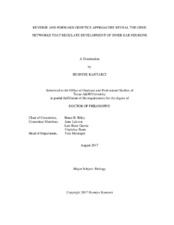| dc.description.abstract | Stato-Acoustic Ganglion (SAG) neurons originate from the floor of the otic vesicle during a brief developmental window. They subsequently leave the otic vesicle and undergo a phase of migration and proliferation (transit-amplification). Neuroblasts finally differentiate into mature SAG neurons and extend processes to connect sensory cells of the inner ear to the information processing centers in the brain. The goal of this dissertation has been to elucidate mechanisms controlling these diverse events, which have heretofore been only poorly understood.
First we showed that a threshold level of Fgf signaling initially sets the neurogenic domain in the otic epithelium. However, the level of Fgf signaling increases during development and becomes inhibitory to otic neurogenesis. Specfically, fgf5 is expressed by accumulating SAG neurons, which serves to terminate specification of new neuroblasts and delay differentiation of transit-amplifying cells.
Second, we tested the role of transcription factor tfap2a, which we found is expressed in the neurogenic domain in both zebrafish and chick. Gain and loss-of-function studies revealed that Tfap2a activates expression of bmp7a, which in turn partially inhibits Fgf and Notch signaling. By modulating the inhibitory functions of Fgf and Notch, Tfap2a regulates the duration, amount and speed of SAG development.
Third, we investigated the mechanism by which SAG neuroblasts leave the otic epithelium. We showed that Goosecoid (Gsc) regulates epithelial-mesenchymal transition of the otic neuroblasts. Fgf signaling regulates expression of gsc in a region iii partially overlapping with the neurogenic otic domain. The medial marker Pax2a acts in opposition to Gsc and stabilizes otic epithelia in non-neurogenic parts of the otic vesicle.
Lastly, we conducted a mutagenesis screen in zebrafish to identify ENU-induced mutations that affect SAG development. We recovered a SAG deficient mutation, termed sagd1 that strongly reduces a subset of SAG neurons required for vestibular (balance) functions. Whole genome sequencing revealed that sagd1 affects the glycolytic enzyme, Phosphoglycerate kinase-1 (Pgk1). Further analysis revealed that Pgk1 acts nonautonomously to augment Fgf signaling during early stages of otic neurogenesis.
Together, these studies have uncovered a number of previously unknown mechanisms for dynamic regulation of Fgf to control specification, delamination, and maturation of SAG neurons. | en |


